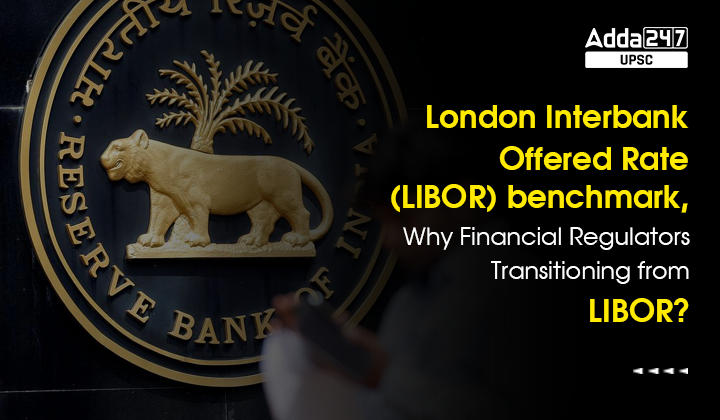Table of Contents
LIBOR Benchmark: LIBOR, which stands for the London Interbank Offered Rate, is a global benchmark interest rate. It represents the average interest rate at which major banks estimate they can borrow from each other in the London interbank market for various periods of time. LIBOR Benchmark is also important for UPSC Prelims Exam and UPSC Mains Exam (GS Paper 3- Indian Economy and Indian banking system).
LIBOR Benchmark in News
Recently, the Reserve Bank of India (RBI) stated that certain banks and financial institutions have not fully completed the transition away from the London Interbank Offered Rate (LIBOR) benchmark.
- They have not incorporated fallback clauses in all their financial contracts that rely on U.S. dollar LIBOR or the Mumbai Interbank Forward Outright Rate (MIFOR) in India.
- It is important to note that both LIBOR and MIFOR will no longer be considered representative benchmarks from June 30th of this year.
LIBOR Benchmark
LIBOR is an internationally recognized benchmark interest rate that reflects the rates at which banks estimate they can borrow funds from one another in the London interbank market.
- It serves as a reference rate for settling trades in various financial instruments such as futures, options, swaps, and other derivatives in both over-the-counter markets and exchanges worldwide.
- Additionally, consumer lending products such as mortgages, credit cards, and student loans often utilize LIBOR as a benchmark rate.
How LIBOR is Calculated?
Each business day prior to 11 a.m. (London time), banks that are part of the LIBOR panel submit their rates to Thomson Reuters, a news and financial data company.
- The panel consists of major banks like J.P. Morgan Chase (London branch), Lloyds Bank, Bank of America (London branch), Royal Bank of Canada, UBS AG, and others.
- Once the submissions are received, the rates are ranked, excluding the extreme quartiles (top and bottom).
- The middle quartiles are then averaged to determine the final LIBOR rate. The aim is to closely align with the median rate.
Associated Concerns with LIBOR Benchmarking
The fundamental flaw in the LIBOR mechanism was its heavy reliance on the honesty of reporting by banks, without considering their commercial interests.
- It is important to note that the rates were publicly disclosed, so it would not have been beneficial for banks to highlight the disadvantages of obtaining funds to potential or existing customers.
- This issue became particularly evident during the 2008 financial crisis when submissions were manipulated, resulting in artificially lowered rates.
- In 2012, Barclays acknowledged this misconduct and agreed to pay a $160 million penalty to the U.S. Department of Justice.
- The Wall Street Journal also conducted a study in May 2008, revealing that several panelists were benefiting from “significantly lower borrowing costs” compared to other market indicators.
- Additionally, it was observed that submissions were sometimes adjusted (higher or lower) based on the derivative positions of the entities’ trading units in order to generate higher profits.
Secured Overnight Financing Rate (SOFR), an Alternative to LIBOR
In 2017, the U.S. Federal Reserve introduced the Secured Overnight Financing Rate (SOFR) as a preferred alternative to LIBOR. Following this development, new transactions in India were required to use SOFR and the Modified Mumbai Interbank Forward Outright Rate (MMIFOR), replacing MIFOR.
- According to the International Finance Corporation (IFC), SOFR is based on observable repo rates, which represent the cost of borrowing cash overnight collateralized by U.S. Treasury securities.
- This structure makes it a transaction-based rate, reducing reliance on subjective judgments as seen in LIBOR.
- Consequently, SOFR is potentially less susceptible to market manipulation.
Steps taken by RBI
In its November 2020 bulletin, the Reserve Bank of India (RBI) highlighted that in India, exposure to LIBOR primarily existed in loan contracts, Foreign Currency Non-Resident Accounts (FCNR-B) deposits with floating interest rates, and derivatives.
- To prepare for the transition away from LIBOR, the RBI had directed banks in August of the same year to assess their LIBOR exposures and make necessary arrangements for adopting alternative reference rates.
- The RBI also mandated that contracts entered after December 31, 2021, should not use LIBOR as a reference rate.
- Additionally, contracts entered before that date were required to include fallback clauses, ensuring that revised considerations would be determined in the event that the reference rate ceased to be published.
- These measures aimed to enhance transparency and consistency in the financial system.



 TSPSC Group 1 Question Paper 2024, Downl...
TSPSC Group 1 Question Paper 2024, Downl...
 TSPSC Group 1 Answer key 2024 Out, Downl...
TSPSC Group 1 Answer key 2024 Out, Downl...
 UPSC Prelims 2024 Question Paper, Downlo...
UPSC Prelims 2024 Question Paper, Downlo...
